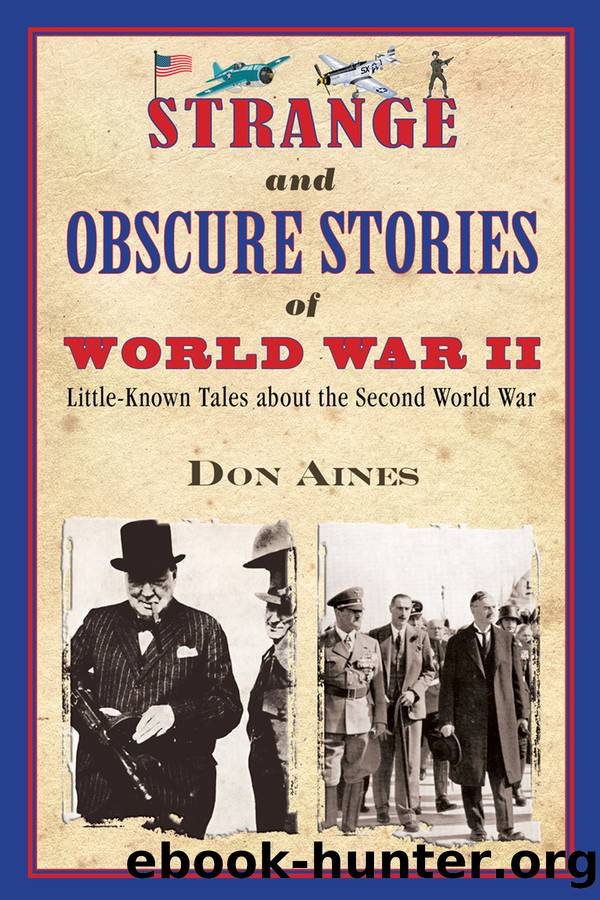Strange and Obscure Stories of World War II: Little-Known Tales About the Second World War by Don Aines

Author:Don Aines [Aines, Don]
Language: eng
Format: epub
Tags: history, Military, World War II, General, Europe, Great Britain, 20th Century
ISBN: 9781510746862
Google: Vva7DwAAQBAJ
Publisher: Simon and Schuster
Published: 2020-10-06T23:47:41.498817+00:00
Wayne Morris took a break from his Hollywood career to play his greatest role, U.S. Navy ace. Morris earned his wings before the war, after playing the second lead in Flight Angels.
Morris joined the Naval Reserve before Pearl Harbor and in 1942 took Patricia Ann OâRourke as his wife. OâRourkeâs uncle was Lieutenant Commander David McCampbell, who would go on to command Air Group 15, the fighter, dive-bomber, and torpedo-bomber squadrons that would serve a memorable deployment on the USS Essex in 1944. Morris took advantage of his uncle-in-law not to avoid combat but to ensure he was in the thick of the fighting.
About the time McCampbell was taking command of VF-15 (the fighter squadron for Air Group 15), Morris was a primary flight-training instructor in Hutchinson, Kansas, according to McCampbellâs Heroes by Edwin P. Hoyt. Morris asked McCampbell to get him into a fighter squadron and McCampbell told him, âGive me a letter.â
Morris wrote that letter, but instead of a fighter squadron he found himself transferred to a PBY (patrol-bomber) unit in Jacksonville, Florida. Hoyt wrote that Morris was assigned to Catalina amphibious aircraft because of his size. When he ran into McCampbell in Jacksonville, Morris again asked McCampbell to âget me into fighters.â
âMcCampbell wanted men who wanted to be fighter pilots more than anything else,â Hoyt wrote. Morris got his transfer to VF-15, or âFighting Fifteen.â
For carrier pilots, the danger began months before their first combat sortie. There has never been an aircraft produced in any numbers that did not crash due to pilot error or mechanical failure, and the Hellcat was no exception. Nor was the Helldiver or the Grumman Avenger torpedo plane. In the months of training leading up to deployment on the Essex, Air Group 15 lost a dozen pilots and crewman and at least as many planes. Routine military flight training was dangerous under the best of circumstances. When attempting a takeoff or landing from a carrier deck pitching and rolling ten or twenty feet in heavy seas, it could be downright deadly. And the Hellcat pilots were expected to do more than shoot down Betty bombers and mix it up with Zeros, Oscars, Tonys, and Hamps. They were also trained in bombing and strafing sea and land targets.
Lieutenant Morris splashed his first Zero off Guam on June 20, 1944, part of the harvest of Japanese aircraft known to history as the âGreat Marianas Turkey Shoot.â He got after a Zero that dove out of the clouds to attack Helldivers starting to make their runs. After three passes by Morris, the smoking Zero ploughed into the sea. Morris and two other pilots ganged up on a Japanese patrol plane over Mindanao on September 9, and the next day he led a fighter sweep over two airfields, lighting up camouflaged fuel dumps secreted in a wooded area. He bagged another Zero on September 13. A few days later, he and another pilot rocketed a docked submarine. The Hellcat was a good platform for rockets and
Download
This site does not store any files on its server. We only index and link to content provided by other sites. Please contact the content providers to delete copyright contents if any and email us, we'll remove relevant links or contents immediately.
| Africa | Americas |
| Arctic & Antarctica | Asia |
| Australia & Oceania | Europe |
| Middle East | Russia |
| United States | World |
| Ancient Civilizations | Military |
| Historical Study & Educational Resources |
Machine Learning at Scale with H2O by Gregory Keys | David Whiting(4190)
Never by Ken Follett(3796)
Fairy Tale by Stephen King(3220)
The Man Who Died Twice by Richard Osman(2997)
Oathbringer (The Stormlight Archive, Book 3) by Brandon Sanderson(2891)
Will by Will Smith(2794)
Rationality by Steven Pinker(2291)
The Dark Hours by Michael Connelly(2246)
Can't Hurt Me: Master Your Mind and Defy the Odds - Clean Edition by David Goggins(2229)
The Dawn of Everything: A New History of Humanity by David Graeber & David Wengrow(2123)
Friends, Lovers, and the Big Terrible Thing by Matthew Perry(2123)
Principles for Dealing With the Changing World Order: Why Nations Succeed and Fail by Ray Dalio(1974)
HBR's 10 Must Reads 2022 by Harvard Business Review(1778)
A Short History of War by Jeremy Black(1763)
Go Tell the Bees That I Am Gone by Diana Gabaldon(1687)
515945210 by Unknown(1601)
A Game of Thrones (The Illustrated Edition) by George R. R. Martin(1591)
Kingdom of Ash by Maas Sarah J(1529)
443319537 by Unknown(1470)
